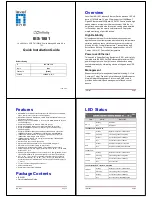
CHAPTER 8: Operation
83
Of course, any time that more than the maximum independent number of users are trying to access
computers attached to a single ServSwitch Multi unit, two, four, or eight of them will have independent access
and the rest must share. Any attempt by a sharing user to connect to a third/fifth/ninth computer attached to
the same Switch will be ignored. Figure 8-1 below shows a “mandatory sharing” system with five consoles. The
users on consoles 3, 4, and 5 are using computers B through D respectively. They are working simultaneously
and independently of each other. Consoles 1 and 2 are sharing computer A. Both consoles display video from
computer A, but only one of the consoles can have actual control of the computer at any given moment.
Figure 8-1. Independent vs. shared access in a multiuser system.
In cascaded systems, the situation becomes more complicated. Each individual ServSwitch Multi still has two,
four, or eight data pathways, but when a user selects a computer on another Switch, one pathway in each Switch
between the user’s console and the computer will be occupied. For example, refer to Figure 6-4 in
Section 6.1
:
For a user on Switch 0 to establish an independent connection to a computer on Switch 5, it would require the
use of one data pathway in Switch 5 (from the CPU-Interface Card to the Transmit-Card port), one pathway in
Switch 4 (from Receive-Card port to Transmit-Card port), one in Switch 1 (Receive-Card port to Transmit-Card
port), and one in Switch 0 (Receive-Card port to local console or User-Interface Card).
When you need to figure out the dynamics of data-path usage in any local ServSwitch Multi in a cascaded
ServSwitch Multi system, just remember that each of these connections takes up one data path through the unit:
• Local console to local computer.
• Local console to remote computer through a port on a local Receive Card.
• Remote console to local computer through a port on a local Transmit Card.
• Remote console to remote computer through ports on local Transmit and Receive Cards.
In cascaded systems, shared access applies not only to computers but also to expansion connections. If one
ServSwitch Multi is attached to another by only a single link (from a Transmit-Card port on one Switch to a
Receive-Card port on the other), and an active user at a console on the Switch with the Receive Card selects a
computer on the Switch with the Transmit Card, other users on the Receive-Card switch can share access to that
computer, but they cannot establish an independent connection to any computer on the Transmit-Card Switch
until the active user selects a computer on a different Switch and relinquishes his or her “lock” on the
expansion connection.
Console 1
Console 2
Console 3
Console 4
INDEPENDENT ACCESS
SHARED
ACCESS
Console 5
Computer D
Computer C
Computer B
Computer A
Com. A
Video
Com. B
Video
Com. C
Video
Com. A
Video
Com. D
Video
















































